
95% of researchers rate our articles as excellent or good
Learn more about the work of our research integrity team to safeguard the quality of each article we publish.
Find out more
ORIGINAL RESEARCH article
Front. Environ. Sci. , 30 May 2024
Sec. Water and Wastewater Management
Volume 12 - 2024 | https://doi.org/10.3389/fenvs.2024.1390101
We evaluated the operational, financial, and management challenges within China’s Toilet Revolution by surveying 656 rural households across 10 provinces. The results revealed that the majority of households which renovated their toilets under the Toilet Revolution perceived positive impacts of this on their quality of life and living conditions. Households that had undertaken toilet renovations viewed the program more favorably than households which had not undertaken renovation, and were more willing to engage with the program. Despite the perceived benefits, households were generally hesitant to personally invest in toilet renovation. We uncovered a gap in strategic sanitation planning for post-construction operation and maintenance of toilets, reflecting a “build first, manage later” approach in the Toilet Revolution. We also identified a widespread lack of formal models for management of toilets and toilet products, coupled with high reliance among households on government support and subsidies to fund renovation. To address operational inefficiencies and financial sustainability issues in the program, we propose a novel “Toilet Business” model that leverages a sanitation value chain approach. In this model, private sector engagement, cost management, and market revitalization are crucial components that must be implemented to ensure the program’s long-term success. Overall, our study provides valuable insights into the complexities of implementing large-scale sanitation programs such as the Toilet Revolution.
Since 1992, when the Chinese State Council first officially recognized the need for an initiative focused on retrofitting rural toilets, China has engaged in continuous improvement of rural sanitation facilities. By 2004, the Chinese government had allocated approximately RMB 8.64 billion towards rural sanitation (Chen et al., 2022). Efforts were further accelerated in 2015, when President Xi Jinping, during a visit to a village, highlighted toilet renovation as an approach to enhance living standards in rural areas and inaugurated the so-called “Toilet Revolution” initiative across the nation (Sripada, 2021). This ambitious program aims to achieve sanitary toilet coverage rates of 85% by 2020 and 100% by 2030 (Zhang et al., 2020). Since its inception, the Toilet Revolution has broadened its focus beyond rural household sanitation facilities to include public restrooms, particularly those in tourist areas. The initiative has resulted in significant achievements over a relatively short period. By 2018, the Toilet Revolution had reached over 10 million households, with a significant majority located in rural areas. However, challenges persist in operation and management of these toilet facilities (Genter et al., 2021; Zhang et al., 2023), including lack of effective collaboration between stakeholders, low community engagement and neglect of sanitation infrastructure ( Yang et al., 2017; Wang et al., 2022; Cheng et al., 2018). Ensuring that improved sanitation facilities meet residents’ expectations is crucial for increasing acceptance and ownership (Li et al., 2024), as failure to do so can inadvertently promote practices such as abandonment of renovated toilets and open urination and defecation (Cherunya et al., 2020; Yan et al., 2021).
The Toilet Revolution has received significant government investment and policy support since it was launched, since it is considered crucial to the nation’s efforts in improving sanitation and living environment across rural areas. However, the success of such programs cannot be solely contingent upon infrastructure development and will require active involvement and acceptance of the local population. In China, the perception of rural households as passive participants in social governance initiatives has historically impacted their engagement and enthusiasm for national programs. As the Toilet Revolution progresses, examining the attitudes and feedback of rural residents towards the management of sanitation systems is crucial, but there has been little research on operational and management aspects of rural toilets built or renovated since the launch of the program. Such insights are essential not only for assessing the program’s impact, but also for identifying areas requiring further attention and improvement.
The overall aim of this study was to evaluate the impact and social sustainability of the Toilet Revolution among rural households across 10 provinces in China. Our main focus was on identifying issues and challenges related to operation, management, and economics of rural toilets. To this end, we considered potential barriers, assessed innovative financing models, and developed actionable strategies to enhance program outcomes and stakeholder satisfaction with the Toilet Revolution in rural areas.
We surveyed 656 households across 10 provinces in seven geographical regions of China (Figure 1) from March to July of 2019, using face-to-face interviews based on a written questionnaire. The interviews were conducted in Mandarin by nine professional environmental engineers who received prior training in interview methods. A list of interviewees was obtained from local authorities and interviewers visited the selected household, asked the set of questions in the questionnaire and recorded the answers in the spaces provided on the printed form. Before the interview, all respondents were informed of the purpose of the study and assured that their participation was voluntary and anonymous, and that their responses would be used only for scientific research. None of the households withdrew in the middle of the interviews.
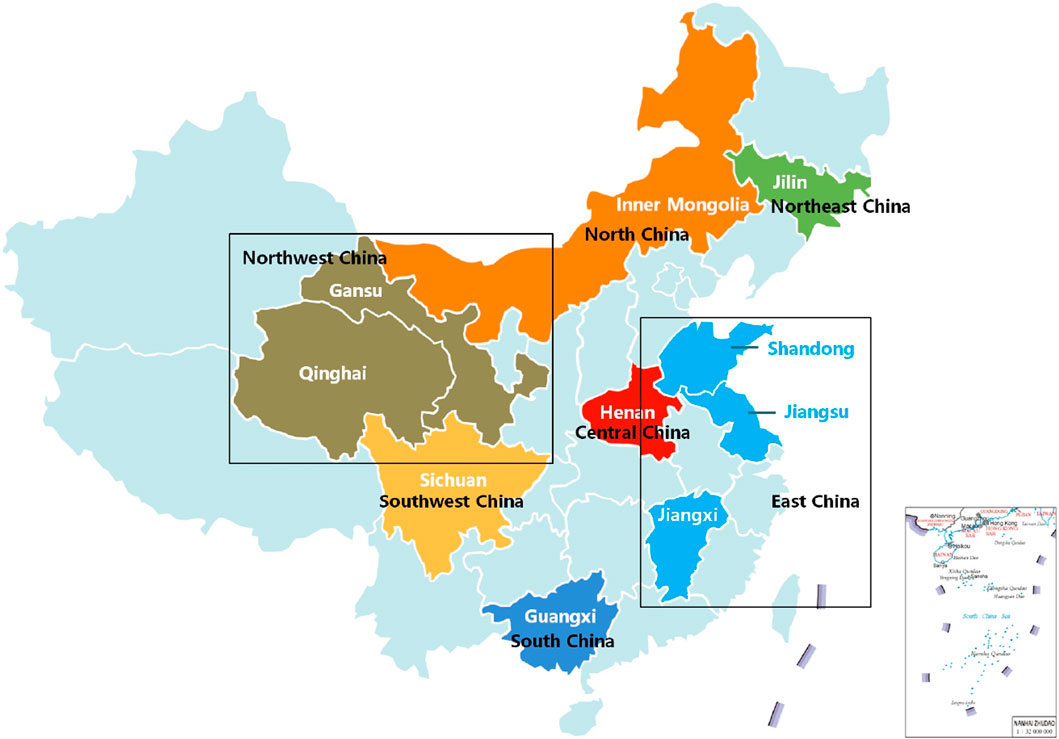
Figure 1. Location of the 10 provinces (Gansu, Guangxi, Henan, Jilin, Jiangsu, Jiangxi, Inner Mongolia, Qinghai, Shandong, and Sichuan) in China in which rural households were surveyed using face-to-face interviews and a questionnaire.
The questionnaire was designed based on our previous knowledge of fecal sludge management practices in China (Guo et al., 2021; Simha et al., 2021; Zhou et al., 2022). A pre-test was conducted with 10 households to test the appropriateness and clarity of the questionnaire, after which some questions were simplified. The study design was approved by the scientific and technological ethics committee of the University of Science and Technology Beijing (Reference number: 2021–5–103), as part of a larger project aimed at field-testing renovated toilets in rural households in China.
The questionnaire used in the main survey consisted of 31 questions divided into three sections (see Supplementary Material). The first section (Q1-Q7) sought information about the participant’s demographic characteristics, including gender, age, education, occupation, household income, and family size. The second section (Q8-Q20) investigated the current state of rural household toilets, including information on type of toilet, if and when the toilet was renovated, whether the household faced issues related to malodor and flies, frequency and convenience of toilet maintenance and cleaning, and models of operation, management, and promotion of toilets in the rural province in which the household was located. The third and final section (Q21-Q31) sought insights into respondent knowledge, awareness, and perceptions of the Toilet Revolution, including motivation for renovating the household toilet, satisfaction with the renovated toilet, quality of living environment, etc. The majority of the questions were closed-ended, with multiple choice or binary response options. In the third section, some open-ended questions were included to allow participants to elaborate on issues related to construction, installation, usage, and maintenance of rural toilets and make suggestions for improving these issues.
Responses to questions involving multiple choices were treated as categorical variables. The Chi-square (χ2) test was used to assess the strength of association between willingness of responding households to participate in the Toilet Revolution’s call for renovating rural toilets and possible explanatory variables (gender, age, education, occupation, annual net income and resident population) (Eq. 1).
where r is the number of rows (e.g., willingness to participate in Toilet Revolution), c is the number of columns (gender, age, education level, occupation, annual income, resident population), nij is the observed value, and Ei is the expected value, given by:
where n is the total number of respondents.
Associations with p < 0.05 were considered statistically significant, where the larger the χ2 value, the greater the difference between the observed value and the expected value, i.e., the stronger the association between the two. Results of the Chi-square test can be found in Supplementary Tables S1, S2.
The socio-demographic characteristics of the 656 rural respondents are shown in Table 1. There was a slightly higher proportion of male respondents (52%) than female respondents (48%). The majority were aged between 40 and 60 years, and were therefore middle-aged according to the United Nations definition (Chen et al., 2022). The respondents had varying degrees of school education and agriculture was the main occupation. Around 60% of the respondents had annual income of less than CNY 20,000. Nearly half of the surveyed households had three or fewer permanent residents. It should be noted that the number of respondents from Gansu province exceeded those from other provinces. This discrepancy arose because the University of Science and Technology Beijing has been offering targeted assistance to a poverty-stricken county in Gansu province, which partly facilitated the organization of households for the survey.
Among the 656 responding households, 251 had renovated their toilet during the previous 5 years as part of the Toilet Revolution. Construction of toilets under the program usually proceeds in one of three ways (Wang et al., 2022). (i) The local government provides raw materials and households build the toilets themselves; (ii) the local government sub-contracts toilet construction by public tender; or (iii) households construct toilets completely by themselves. The policy of the Toilet Revolution dictates that the costs for upgrading toilets will be paid by the government, while other costs must be paid by households. Among the 251 households that undertook toilet renovations, 40% received a full subsidy from the government and the remaining households funded their own toilet renovation. The most common toilets that renovated are “three-chamber septic tank toilets” (44.6%), followed by “mixed-dry toilets” (30.3%), sewage-connected flushing toilets (12.4%), biogas toilets (6.8%) and dual-urn funnel toilet (6.0%). It can be seen that around 70% opting were water-flushing toilet systems. In terms of improving the quality of the indoor environment, 62% of adopting households reported that the renovated toilets were free of flies and mosquitoes (Figure 2A), even during the summer months. Around 72% reported that the toilets reduced malodor (Figure 2B), and >70% considered that the toilets were easy to clean (Figure 2C) and maintain daily (Figure 2D).
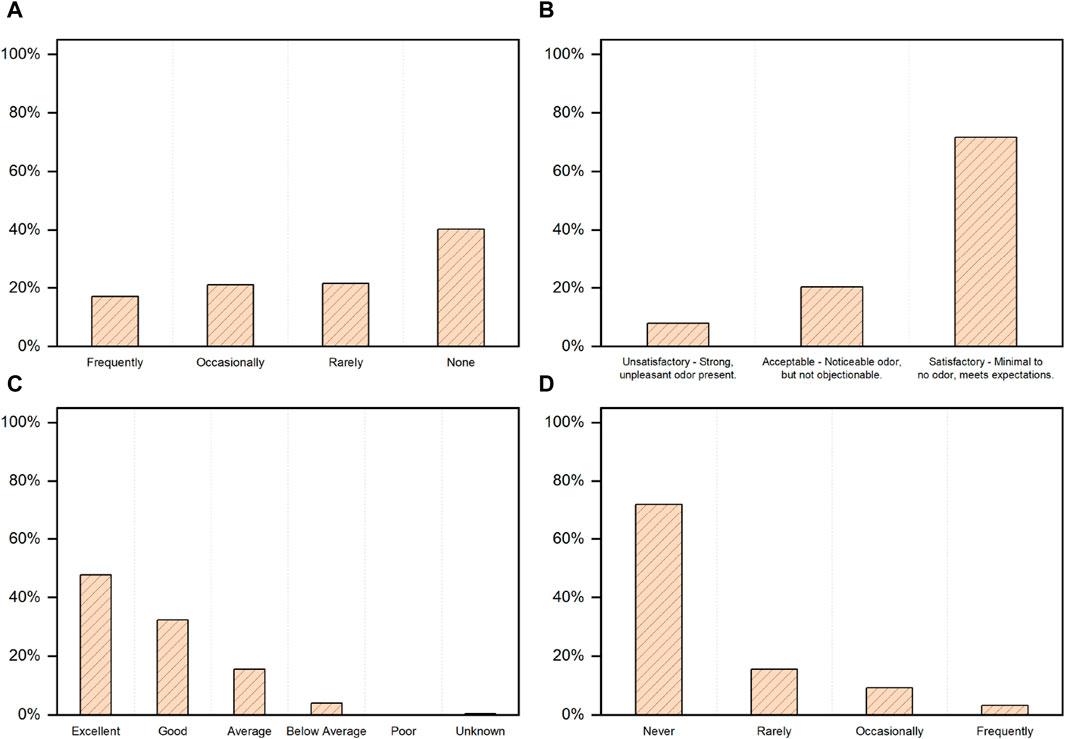
Figure 2. Perceptions of quality of the indoor living environment in households that undertook toilet renovations in terms of (A) number of mosquitoes and flies during summer months, (B) odor, (C) convenience of cleaning the toilet, and (D) frequency of toilet maintenance.
- Among the 405 households that did not renovate toilets over the past 5 years, 87% used dry toilets where urine and feces are collected together, while the rest mostly used existing three-chamber septic tank toilets (Figures 5G–I). In terms of indoor environment quality, half of these households reported that their toilets had issues related to flies and mosquitoes during summer (Figure 3A). Around 72% reported that the toilets smelt bad, of which 33% reported that the malodor was intolerable (Figure 3B). Despite these issues, the majority found the toilets easy to clean (Figure 3C) and maintain without needing repairs (Figure 3D).
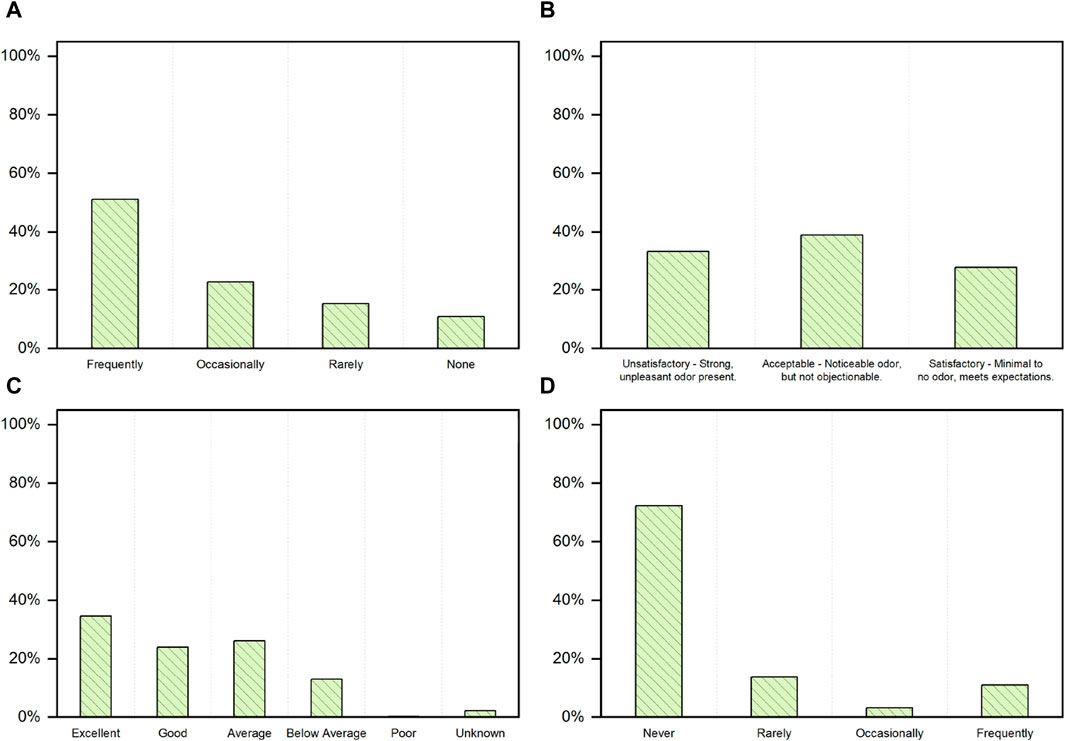
Figure 3. Perceptions of quality of the indoor living environment in households that did not undertake toilet renovations in terms of (A) number of mosquitoes and flies during summer months, (B) odor, (C) convenience of cleaning the toilet, and (D) frequency of toilet maintenance.
When households were asked to express level of satisfaction with their toilets (Figure 4), 78% of the 251 households that had recently renovated their toilets (Figures 5A–C) stated that the toilet met their expectations. In fact, the majority of these households gave their renovated toilet a score of >80 out of 100 and >90% felt that the renovation had improved the quality of their indoor living environment. Dissatisfaction among the 40% of households that had not renovated their toilet within the past 5 years stemmed from safety and convenience issues with dry toilets. As these toilets are usually installed outside the house to avoid malodor, they are inconvenient to use during winter months and bad weather (Figure 5E). There are also risks of children and elderly people falling into the pit (Figures 5D, F). A previous study identified strong odor and low fermentation efficiency as major drawbacks of composting toilets (Gao et al., 2022). For water-flushed toilets, dissatisfaction was linked to the unstable water supply in rural areas, complicating cleaning and odor prevention.
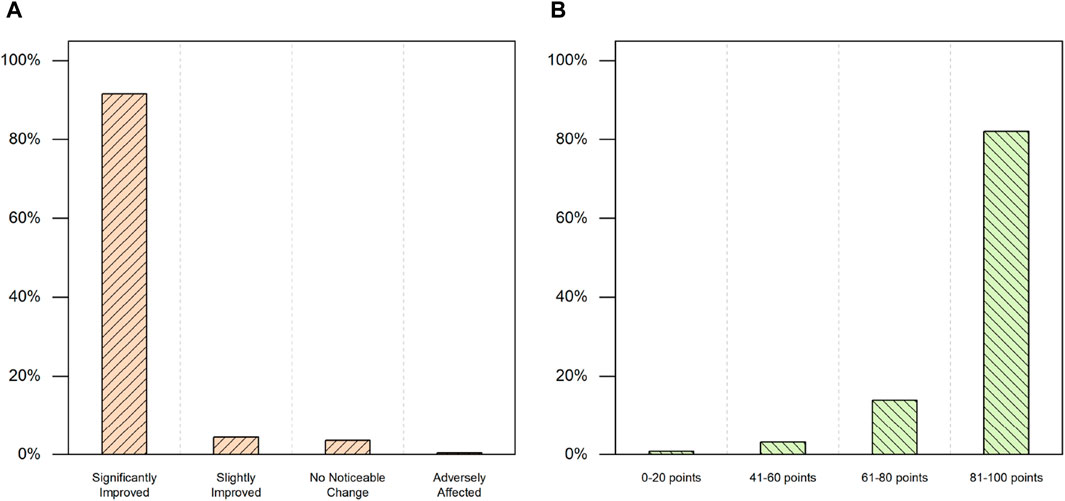
Figure 4. Survey household perceptions (n = 251) of (A) improvement in quality of indoor living environment due to renovated toilets and (B) level of satisfaction (scored 0–100, 100 being extremely satisfied) with renovated toilets.
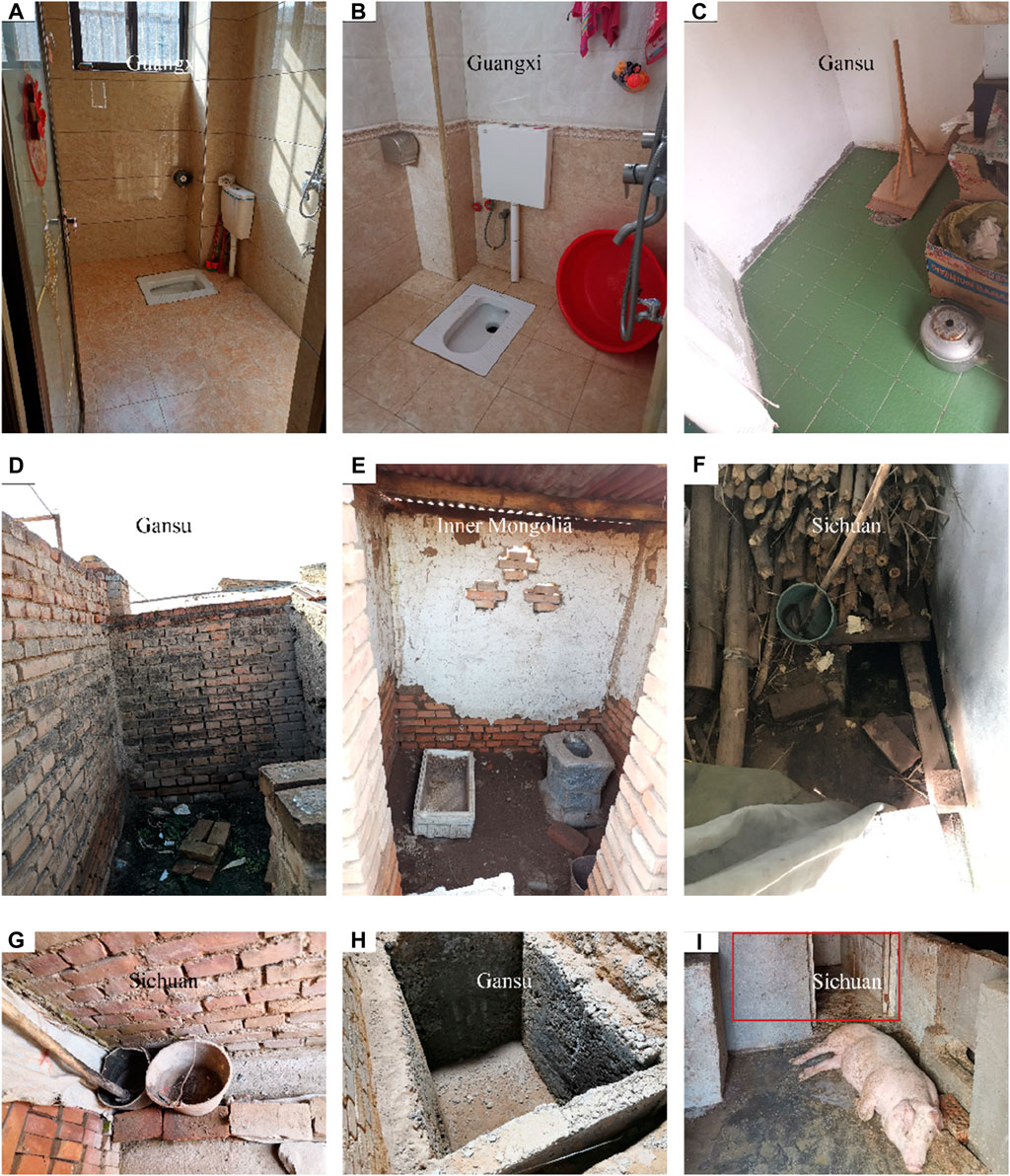
Figure 5. Examples of rural toilets after (A–C) and before (D–F) undergoing renovations as part of the Toilet Revolution. An example of a tool for cleaning toilets (G) and a toilet undergoing renovation (H) are also shown. Despite renovations, some toilets ended up being used as storage spaces or enclosures for livestock (I). All photos taken by the interviewers with the permission of the surveyed households.
We also found that 88% of all households did not have a formal model for toilet operations (e.g., emptying tanks and transferring waste for centralized treatment). Around 80% did not have a model for managing products from sanitation systems (e.g., excreta or biogas) and 72% did not have a clear business idea for maintaining toilets (e.g., how to gain profit from the sanitation service chain). This suggests a “build first, manage later” approach in implementation of the Toilet Revolution, highlighting a need for better planning in sanitation service management and utilization.
The majority of surveyed households were unaware of the Toilet Revolution, with less than 5% having a clear understanding of its objectives (Figure 6A), such as improved sanitation condition, prevent the spread of waterborne disease, recovery nutrients and energy, etc., even though 43% had received publicity and training in relation to the program (Figure 6B). Despite this, over 75% expressed willingness to engage with the Toilet Revolution’s call for action on sanitation issues affecting rural areas. Attitudes of households that had recently renovated their toilet (n = 251) to the Toilet Revolution were relatively more positive than those of households which had not had a recent toilet renovation (n = 405) (Figure 6C). This discrepancy suggests that enhanced awareness and education efforts are needed to ensure broader support and participation in the Toilet Revolution.
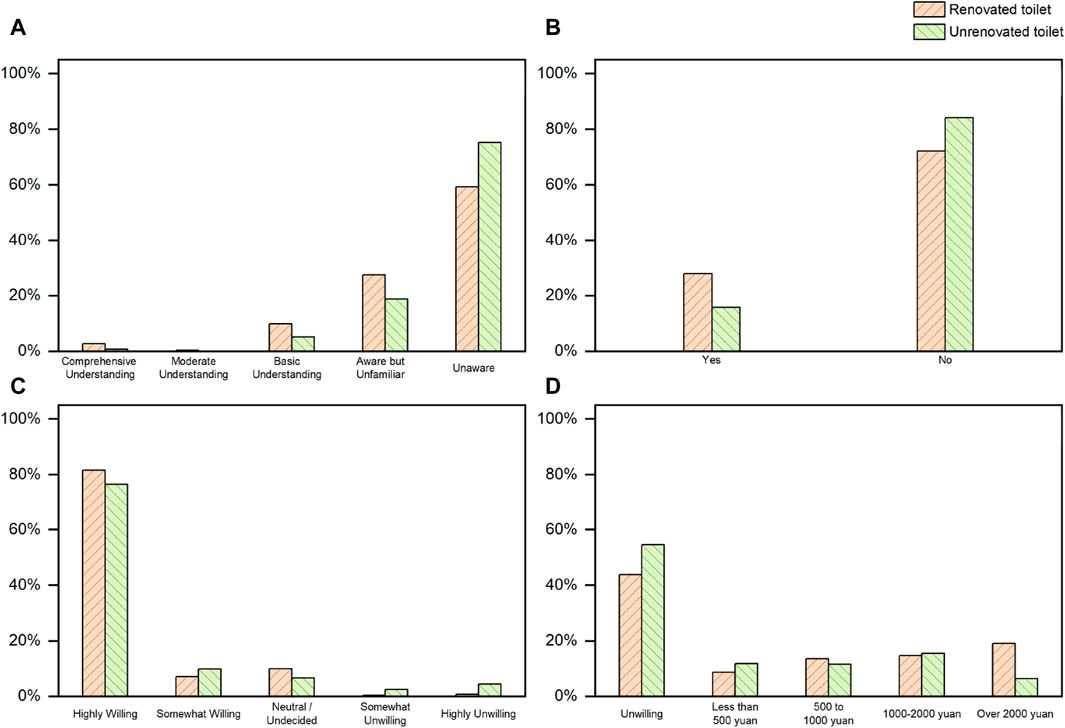
Figure 6. Survey respondents’ attitudes to the Toilet Revolution (survey questions Q26-Q29). Respondents were asked to state (A) their level of understanding of the Toilet Revolution, (B) whether they had received publicity and training related to the Toilet Revolution, (C) their willingness to participate in the Toilet Revolution’s call for action on sanitation issues affecting rural areas, and (D) the amount they were willing to spend on toilet renovation.
When asked about willingness to pay for toilets (Figure 6D), most households responded that they were unwilling to personally finance toilet renovations and supplement government subsidies. Among households that had participated in the Toilet Revolution, 9% were willing to spend less than CNY 500 on retrofitting a toilet, 14% would spend CNY 500-1000, 15% would spend CNY 1000-2000, and only 19% would spend more than CNY 2000. Hence, the rest of them (about 43%) said that they are unwilling to pay. Compared with households that had not performed any renovations a relatively larger proportion of households that had recently renovated their toilets expressed willingness to invest more than CNY 2000 in further renovations. A previous survey found that mean willingness to pay for toilets among rural households was USD 73 (CNY 525) in the Inner Mongolia region and USD 64 (CNY 460) in Shaanxi province (Wu et al., 2019).
Results of Chi-square tests evaluating the strength of association between explanatory variables and willingness of rural households in different provinces in China to participate in the Toilet Revolution’s call for renovating toilets, and their level of satisfaction with current toilets, are shown in Figure 7. For households in Jilin province, net annual household income had a significant negative correlation with willingness to participate in toilet renovation, as households with higher annual income were less willing to participate (Figure 7A). Gender was not a significant explanatory variable determining household attitudes, contradicting findings in a recent study on toilet construction in India (Das et al., 2023). For households in Jiangsu province, age, education level, and occupation were found to significantly affect willingness to participate in toilet renovation. Age and level of education were significant in determining household willingness to participate in toilet renovation in Qinghai and Inner Mongolia, and their level of satisfaction with current toilets (Figure 7B).
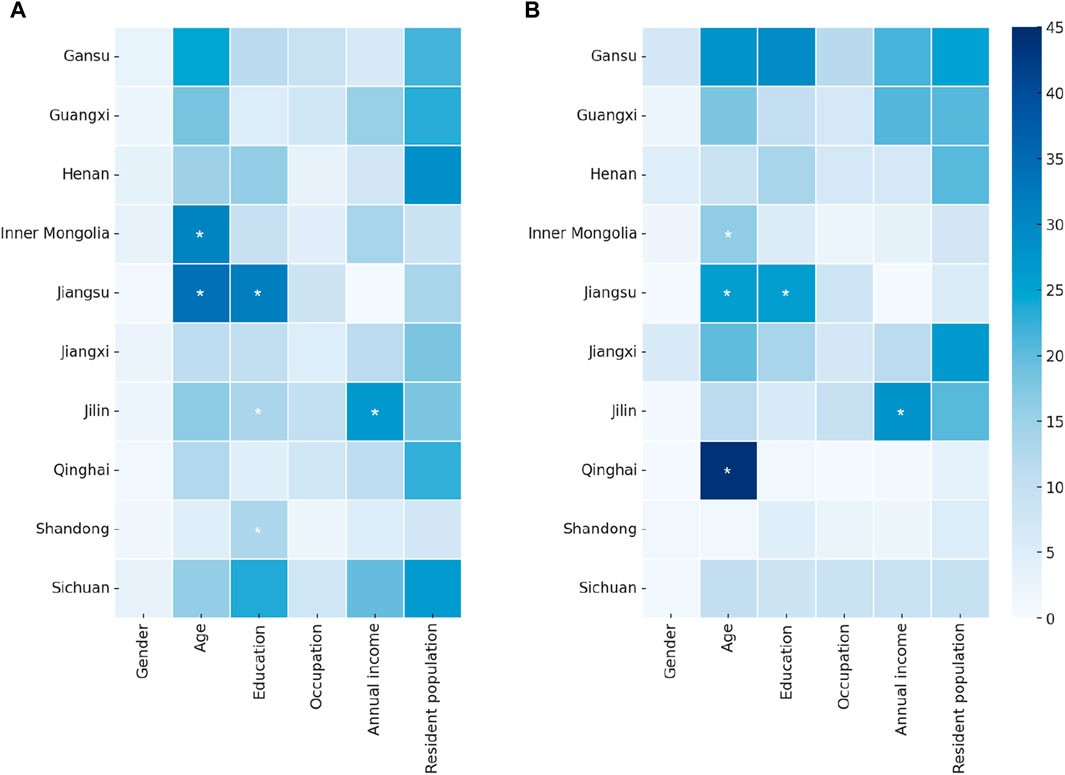
Figure 7. Heatmap representing strength of association for factors (gender, age, level of education, occupation, net annual household income, and resident population) explaining (A) household satisfaction with their current toilet system and (B) willingness of households to participate in the in the Toilet Revolution’s call for renovating toilets. Strength of association (based on Chi-square analysis) for each explanatory factor is arranged by province in alphabetical order. Color intensity correlates with strength of association, an asterisk (*) indicates a province with a statistically significant association.
A predominant view among the survey respondents was that government is the primary driver in promotion of sanitation products and initiatives. However, government efforts alone may fall short in fostering sustainability within the sanitation sector, where involvement of private actors is crucial for construction, operation, and upkeep of sanitation facilities (Wang et al., 2022). In this study we developed a novel approach, called “Toilet Business,” that leverages both governmental and social capital for construction of rural sanitation facilities, with private entities taking on their operation and maintenance. These entities would recoup their investment through various revenue streams, such as leasing spaces, advertising, and the sale of toilet products (e.g., fertilizers, bioenergy). However, our survey revealed stark absence of a formal business model for development and maintenance of sanitation infrastructure in the 10 provinces surveyed. Over 85% of respondents reported a lack of any structured approach, with the majority relying on self-built and self-maintained facilities over time. Only a few of the surveyed households (4%) were cognizant of innovative approaches akin to “Toilet Business.”
Sanitation value chain theory suggests division of the internal value chain into core and auxiliary components to enhance market dynamism and the sustainability of sanitation services (Ushijima et al., 2015; Tadesse and Bekele, 2022) (Figure 8). The core value chain encapsulates basic sanitation system activities, while the auxiliary value chain bolsters these activities. Together, they ensure smooth and efficient function of the system. The core value chain encompasses facility/equipment procurement, production, operation, and marketing, while the auxiliary value chain involves financial management, human resource management, and technological research and development.
Regarding the core value chain, it should be noted that the sanitation market is still at a rudimentary stage (Beard et al., 2022). Given the modest profit margins within the industry, prioritizing cost management is essential for profitability. Among the three routes by which toilets are usually constructed in rural China, securing a contractor via public tender and collaboration with a project management contractor is the prevalent choice. A case in point is the Inner Mongolia Autonomous Region, where a private entity secured a contract for toilet construction at approximately CNY 4000 per household. Since the subsidy provided by government is around CNY 3000, the financial burden on households was reduced to CNY 1000. However, our survey revealed that 23% of the respondents were unwilling to invest CNY 1000 or more in renovating toilets, which suggests that private toilet construction companies must still explore cost-cutting strategies, such as leveraging local materials or opting for cost-effective design solutions (Willetts et al., 2017).
Revitalizing the sanitation market is another strategic avenue that could be explored. The overall commerce market is currently undergoing a shift from a traditional agent-based model to a direct sales model, due to the emergence of e-commerce platforms. It is important to note that rural households in China today have limited choice in terms of toilet design and sanitation technologies, predominantly due to the reliance of these on government directives. This reliance confirms that the Toilet Revolution is largely driven by national policy, rather than grassroots demand or local innovation. However, leveraging the model of existing online shopping platforms could change the rural sanitation landscape. Such platforms could be used to showcase a wide range of toilet products and services, making them readily accessible to the public. As the penetration of mobile phones and internet access in rural areas is high [260 mobile phones and 26 computers per 100 households by the end of the survey year (2019)], there is good potential for e-commerce to revolutionize rural sanitation. While transitioning to e-commerce might not drastically cut procurement costs, it could streamline procurement, tighten cost control, spur market competition, promote innovation in technology, and improve service delivery (Judge et al., 2021).
In the sanitation market, customers serve dual roles, as users and overseers, complicating cost management efforts. Traditional commercial investment models often overlook user considerations, leading to a lack of robust mechanisms for controlling sales costs. This oversight underscores the urgent need for innovative financing strategies to infuse commercial dynamics into the sector and enhance cost efficiency (Traoré et al., 2017). One such strategy is the Public-Private Partnership (PPP) model, where governments can incentivize corporate investment through policy support and tax incentives. Our survey revealed effects of adoption of the “who invests, who benefits” principle in Shandong province, fostering PPP collaborations that attract social capital in constructing tourist-friendly toilets (Li et al., 2021). This approach not only bridges funding gaps, but also aligns investor interests with public sanitation goals.
In most sanitation-related projects, including the Toilet Revolution, the majority of costs derive from acquisition of essential infrastructure, such as squatting or sitting pans and prefabricated septic tanks (Guo et al., 2021; Zhou et al., 2022). A critical challenge lies in financing costs related to toilet operation and maintenance. Reinvesting potential profits derived from resource-oriented sanitation systems that produce valuable products (e.g., fertilizer and biogas) is one approach to overcoming this challenge. In previous studies, we revealed a disproportionate emphasis on upgrading front-end facilities within the “Toilet Renovation” initiative, with the management of human excreta often overlooked (Zhou et al., 2022). The present study revealed prevalent misuse of toilets connected to digesters, who primarily regarded such digester as storage tank, and applied such excreta to farmland directly without sufficient storage time. As was known to all that the biogas digester requires a hydraulic retention time of around 30 days so as to ensure the energy recovery efficiency and hygiene before usage. Barriers to recycling human excreta include inadequate technology, prohibitive costs, and odor issues, rendering the sale of toilet products economically unviable and merely a tactic to circumvent excreta disposal fees. Consequently, the financial viability of rural sanitation systems relies on government subsidies, which are vulnerable to policy shifts and budget cuts, potentially leading to system neglect (Hu et al., 2021). Beyond financial constraints, consumer skepticism about using human excreta as fertilizer plays a significant role. Despite general support for this end-use (Barton et al., 2021), grievances about inconvenience (36%) and costs (10%) associated with recycling are prevalent (Zhou et al., 2022), highlighting the complexity of integrating human waste into agricultural practices both logistically and perceptually. Nonetheless, human excreta represent a vast untapped biological resource. Studies have shown that recycling all human excreta produced annually at global level could power over 138 million households if converted to biogas (Wald, 2017) or replace up to 25% of the synthetic nitrogen and phosphate fertilizer currently used in agriculture (Simha, 2021; Vasiljev et al., 2022). China is particularly well placed to tap into gains from such recycling, as it is home to 25% of the global population.
This study did not fully capture progress of the Toilet Revolution across China. Our analysis was based on data from 10 provinces across seven geographical regions, chosen based on recommendations of local government. This selection process may not have encompassed the diversity of rural sanitation conditions, particularly in more densely populated areas. The scope of management and operational practices for sanitation that could be examined was limited, and in assessment of the sanitation service chain we combined survey data with personal insights on the toilet market. Incorporating material obtained in focus group discussions and in-depth interviews could provide a more nuanced understanding of different stakeholder perspectives, enriching the analysis of the sanitation value chain. The insights presented here are reflective of the current situation, but the Toilet Revolution is an active and evolving program that is influenced by shifting policies and market dynamics.
We surveyed rural households’ attitudes to sanitation facilities in relation to the nationwide “Toilet Renovation” initiative in China 3 years after it was launched. The results showed that the Toilet Revolution has fostered significant improvements in the quality of rural living environment in the 10 provinces surveyed. However, a pronounced dependence on government support among rural households was noted, with substantial investments in toilet infrastructure overshadowing cost considerations in management, operation, and maintenance of toilets. To improve sustainability in rural sanitation, we suggest establishment of a comprehensive sanitation value chain for rural households and a “Toilet Business” model that involves private sector actors. Overcoming challenges in cost management and recognizing the importance of innovative financing mechanisms, like PPP, are also necessary steps to improve the sanitation value chain. Achieving the full potential of the Toilet Revolution in rural areas will necessitate a collaborative effort encompassing government bodies, private enterprises, and the community.
The original contributions presented in the study are included in the article/Supplementary Material, further inquiries can be directed to the corresponding authors.
The studies involving humans were approved by the scientific and technological ethics committee of the University of Science and Technology Beijing (Reference number: 2021–5–103), as part of a larger project aimed at field-testing renovated toilets in rural households in China. The studies were conducted in accordance with the local legislation and institutional requirements. The participants provided their written informed consent to participate in this study.
TL: Conceptualization, Formal Analysis, Methodology, Writing–original draft. YuL: Data curation, Investigation, Software, Writing–original draft. YoL: Data curation, Investigation, Writing–review and editing. ZL: Funding acquisition, Writing–review and editing, Resources. XZ: Conceptualization, Project administration, Supervision, Writing–review and editing. PS: Funding acquisition, Project administration, Supervision, Writing–review and editing.
The author(s) declare that financial support was received for the research, authorship, and/or publication of this article. PS was supported by funding from the Research Council of Norway (Grant No. 335008) for the project “Food Security Through Better Sanitation: The Case of Urine Recycling.”
The authors gratefully acknowledge support from the National Natural Science Foundation of China (Grant Nos 52261145693 and 52270020). The authors are also grateful for support from the Key Laboratory of Urban Water Supply, Water Saving, and Water Environment Governance in the Yangtze River Delta of the Ministry of Water Resources in Shanghai. This study would not have been possible without the contributions of the nine professional environmental engineers who administered the survey across the provinces.
The authors declare that the research was conducted in the absence of any commercial or financial relationships that could be construed as a potential conflict of interest.
The author(s) declared that they were an editorial board member of Frontiers, at the time of submission. This had no impact on the peer review process and the final decision.
All claims expressed in this article are solely those of the authors and do not necessarily represent those of their affiliated organizations, or those of the publisher, the editors and the reviewers. Any product that may be evaluated in this article, or claim that may be made by its manufacturer, is not guaranteed or endorsed by the publisher.
The Supplementary Material for this article can be found online at: https://www.frontiersin.org/articles/10.3389/fenvs.2024.1390101/full#supplementary-material
Barton, M. A., Simha, P., Magri, M. E., Dutta, S., Kabir, H., Selvakumar, A., et al. (2021). Attitudes of food consumers at universities towards recycling human urine as crop fertiliser: a multinational survey dataset. Data Brief 35, 106794. doi:10.1016/j.dib.2021.106794
Beard, V. A., Satterthwaite, D., Mitlin, D., and Du, J. (2022). Out of sight, out of mind: understanding the sanitation crisis in global South cities. J. Environ. Manag. 306, 114285. doi:10.1016/j.jenvman.2021.114285
Chen, B., Jin, F., and Zhu, Y. (2022). The impact of access to sanitary toilets on rural adult residents’ health: evidence from the China family panel survey. Front. Public Health 10, 1026714. doi:10.3389/fpubh.2022.1026714
Cheng, S., Li, Z., Uddin, S. M. N., Mang, H. P., Zhou, X., Zhang, J., et al. (2018). Toilet revolution in China. J. Environ. Manag. 216, 347–356. doi:10.1016/j.jenvman.2017.09.043
Cherunya, P. C., Ahlborg, H., and Truffer, B. (2020). Anchoring innovations in oscillating domestic spaces: why sanitation service offerings fail in informal settlements. Res. Policy 49, 103841. doi:10.1016/j.respol.2019.103841
Das, U., Kuang, J., Ashraf, S., Shpenev, A., and Bicchieri, C. (2023). Women as pioneers: examining their role in decision making on toilet construction in India. J. Hum. Dev. Capab. 24, 70–97. doi:10.1080/19452829.2022.2111410
Gao, Yi, Tan, Lu, Zhang, C., Li, Q., Wei, X., Yang, B., et al. (2022). Assessment of environmental and social effects of rural toilet retrofitting on a regional scale in China. Front. Environ. Sci. 10, 812727. doi:10.3389/fenvs.2022.812727
Genter, F., Willetts, J., and Foster, T. (2021). Faecal contamination of groundwater self-supply in low- and middle income countries: systematic review and meta-analysis. Water Res. 201, 117350. doi:10.1016/j.watres.2021.117350
Guo, S., Zhou, X., Simha, P., Mercado, L. F. P., Lv, Y., and Li, Z. (2021). Poor awareness and attitudes to sanitation servicing can impede China's rural toilet revolution: evidence from western China. Sci. Total Environ. 794, 148660. doi:10.1016/j.scitotenv.2021.148660
Hu, M., Xiao, J., Fan, B., Sun, W., and Zhu, S. (2021). Constructing and selecting optimal sustainable sanitation system based on expanded structured decision-making for global sanitation and resources crisis. J. Clean. Prod. 318, 128598. doi:10.1016/j.jclepro.2021.128598
Judge, M., de Hoog, O., Perlaviciute, G., Contzen, N., and Steg, L. (2021). From toilet to table: value-tailored messages influence emotional responses to wastewater products. Biotechnol. Biofuels 14, 79. doi:10.1186/s13068-021-01931-z
Li, Y., Cheng, S., Chen, X., Gao, M., Chen, C., Huba, E. M., et al. (2024). What makes residents participate in the rural toilet revolution? Environ. Sci. Ecotechnology 19, 100343. doi:10.1016/j.ese.2023.100343
Li, Y., Cheng, S., Li, Z., Song, H., Guo, M., Li, Z., et al. (2021). Using system dynamics to assess the complexity of rural toilet retrofitting: case study in eastern China. J. Environ. Manag. 280, 111655. doi:10.1016/j.jenvman.2020.111655
Simha, P. (2021). Alkaline Urine Dehydration: how to dry source-separated human urine and recover nutrients? Acta Univ. Agric. Sueciae 2021, 28.
Simha, P., Bartona, M. A., Perez-Mercado, L. F., McConville, J. R., Lalander, C., Magri, M. E., et al. (2021). Willingness among food consumers to recycle human urine as crop fertiliser: evidence from a multinational survey. Sci. Total Environ. 765, 144438. doi:10.1016/j.scitotenv.2020.144438
Sripada, K. (2021). Child health and wellbeing in a changing climate. Eur. J. Public Health 31, 3. doi:10.1093/eurpub/ckab164.025
Tadesse, B., and Bekele, K. (2022). Scope of vegetable and root crops value chain in Ethiopia. J. Agric. Food Res. 10, 100402. doi:10.1016/j.jafr.2022.100402
Tong, Y., Long, R., Cui, X., Zhu, D., and Chen, H. (2017). Application of the public–private partnership model to urban sewage treatment. J. Clean. Prod. 142, 1065–1074. doi:10.1016/j.jclepro.2016.04.152
Traoré, M. B., Dakouré, M. S., and Maïga, A. H. (2017). Ameli-EAUR project: which lessons for the promotion of agricultural value chains? IOP Conf. Ser. Earth Environ. Sci. 60, 012033. doi:10.1088/1755-1315/60/1/012033
Ushijima, K., Funamizu, N., Nabeshima, T., Hijikata, N., Ito, R., Sou, M., et al. (2015). The Postmodern Sanitation: agro-sanitation business model as a new policy. Water Policy 17, 283–298. doi:10.2166/wp.2014.093
Vasiljev, A., Simha, P., Demisse, N., Karlsson, C., Randall, D. G., and Vinneras, B. (2022). Drying fresh human urine in magnesium-doped alkaline substrates: capture of free ammonia, inhibition of enzymatic urea hydrolysis & minimisation of chemical urea hydrolysis. J. Chem. Eng. 428, 9. doi:10.1016/j.cej.2021.131026
Wang, D., and Shen, Y. (2022). Sanitation and work time: evidence from the toilet revolution in rural China. World Dev. 158, 105992. doi:10.1016/j.worlddev.2022.105992
Wang, Y., Zhu, Y., Qi, C., and Li, L. (2022). Potential barriers in implementing the rural toilet retrofitting project: a qualitative study in Jiaozuo, China. Front. Public Health 10, 965150. doi:10.3389/fpubh.2022.965150
Willetts, J., Gero, A., Susamto, A. A., Sanjaya, R., Trieu, T. D., Murta, J., et al. (2017). Sanitation value chains in low density settings in Indonesia and Vietnam: impetus for a rethink to achieve pro-poor outcomes. J. Water, Sanitation Hyg. Dev. 7, 445–454. doi:10.2166/washdev.2017.141
Wu, S., Li, H., Li, Q., and Mi, L. (2019). Assessing willingness to pay for upgrading toilets in rural areas of Shaanxi and Inner Mongolia, China. Desalination Water Treat. 156, 106–115. doi:10.5004/dwt.2019.23992
Yan, R., Cheng, S., Chen, J., Li, X., Sharma, S., Nazim Uddin, S. M., et al. (2021). Operating status of public toilets in the Hutong neighborhoods of Beijing: an empirical study. J. Environ. Manag. 287, 112252. doi:10.1016/j.jenvman.2021.112252
Zhang, S., Li, Yu, Zhang, Y., Lu, Z. N., and Hao, Y. (2020). Does sanitation infrastructure in rural areas affect migrant workers’ health? Empirical evidence from China. Environ. Geochem Health 42, 625–646. doi:10.1007/s10653-019-00396-2
Yang, T., Long, R., Cui, X., Zhu, D., and Chen, H. (2017). Application of the public–private partnership model to urban sewage treatment. J. Clean. Prod. 142, 1065–1074. doi:10.1016/j.jclepro.2016.04.152
Zhang, Y., Li, F., Lei, Y., Chen, B., Xiong, T., and Wu, J. (2023). The obstacles to China’s rural toilet revolution discussed on social media: a content analysis of Weibo posts and Zhihu answers data. Environ. Sci. Policy 142, 173–182. doi:10.1016/j.envsci.2023.02.010
Keywords: sanitation, household toilets, sanitation service chain, nutrient recycling, operation and management
Citation: Li T, Li Y, Li Y, Li Z, Zhou X and Simha P (2024) Leveraging a sanitation value chain framework could address implementation challenges and reinvent China’s Toilet Revolution in rural areas. Front. Environ. Sci. 12:1390101. doi: 10.3389/fenvs.2024.1390101
Received: 22 February 2024; Accepted: 08 May 2024;
Published: 30 May 2024.
Edited by:
Maria Elisa Magri, Federal University of Santa Catarina, BrazilReviewed by:
Kangning Xu, Beijing Forestry University, ChinaCopyright © 2024 Li, Li, Li, Li, Zhou and Simha. This is an open-access article distributed under the terms of the Creative Commons Attribution License (CC BY). The use, distribution or reproduction in other forums is permitted, provided the original author(s) and the copyright owner(s) are credited and that the original publication in this journal is cited, in accordance with accepted academic practice. No use, distribution or reproduction is permitted which does not comply with these terms.
*Correspondence: Xiaoqin Zhou, emhvdXhpYW9xaW4wMjVAMTYzLmNvbQ==; Prithvi Simha, cHJpdGh2aS5zaW1oYUBzbHUuc2U=
Disclaimer: All claims expressed in this article are solely those of the authors and do not necessarily represent those of their affiliated organizations, or those of the publisher, the editors and the reviewers. Any product that may be evaluated in this article or claim that may be made by its manufacturer is not guaranteed or endorsed by the publisher.
Research integrity at Frontiers

Learn more about the work of our research integrity team to safeguard the quality of each article we publish.